Every six months or so, the Yu-Gi-Oh! TCG gets some scheduled maintenance. Arriving in the form of the Forbidden and Limited lists, the changes it brings always create some interesting new trends that players have to adapt to in order to remain successful. Identify those trends early, and you can get an edge on the opposition. Fail to recognize them, and you may find your tournament performance lagging. Let’s break down the new Forbidden/Limited list that was released earlier this week, and examine what kinds of trends each individual change is likely to create.
Newly Forbidden
Breaker the Magical Warrior: Let’s be honest—Breaker was a no-brainer staple for just about any deck that tried to win through battle. No matter what you were running, and no matter how dedicated you were to your deck’s theme, you ran Breaker. The ability to have a beatstick and a piece of spell or trap removal in one card was just too good to pass up, and the fact that Breaker would often fulfill both roles in a single turn made him overpowered. Now, he’s gone.
The impact of this change? Well, we’ll all get to do a bit more thinking when we start fleshing out our monster line-ups: the immediate brainless choice is gone. In addition, duelists may have to consider other forms of spell and trap removal now that Heavy Storm and Mystical Space Typhoon are the only remaining mainstream picks for this purpose. Expect Giant Trunade, Dust Tornado, Chiron the Mage, and Snipe Hunter to see increases in play.
Magician of Faith: This card was in the same boat as Breaker. Most duelists regarded it as a must-run regardless of what they were playing, and that sapped creativity out of the deck-building process. Now, we’ve got one more monster slot to be creative with.
Of course, this change goes a lot further than that. When you draw into a power card like Heavy Storm or Snatch Steal, you’re going to have to think long and hard before you use it, because you won’t have an easy way to bring it back from the graveyard. Doing so now carries the hefty cost of two discards, as demonstrated by Spell Reproduction and Magical Stone Excavation. That’ll make for some tough decision-making, benefiting experienced players in the long run. Any changes that necessitate more thought on behalf of the player are generally healthy for the game, so expect to put a bit more effort into how you use your spells.
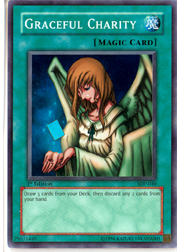 Graceful Charity: With Dark World getting a big boost from Strike of Neos, Graceful Charity was going to become a bigger hindrance to a healthy environment—even moreso than it already is. Forbidding it from Advanced format play balances Dark World in the wake of Strike of Neos, and eliminates a lot of cheap, luck-driven plays. Graceful Charity into a Dark World monster, Graceful Charity into Treeborn Frog . . . basically, “Graceful into anything that happens to be awesome to discard” comes to mind, and we’ll no longer have to cringe at those kinds of moves. On the one hand, a skilled player was always going to use Graceful Charity a bit better than a less experienced one. But that didn’t stop Graceful from creating huge rewards where they weren’t earned, and a lucky Graceful was almost always better than a skillful Graceful. It’s just one more lucksack card gone from tournament play.
Graceful Charity: With Dark World getting a big boost from Strike of Neos, Graceful Charity was going to become a bigger hindrance to a healthy environment—even moreso than it already is. Forbidding it from Advanced format play balances Dark World in the wake of Strike of Neos, and eliminates a lot of cheap, luck-driven plays. Graceful Charity into a Dark World monster, Graceful Charity into Treeborn Frog . . . basically, “Graceful into anything that happens to be awesome to discard” comes to mind, and we’ll no longer have to cringe at those kinds of moves. On the one hand, a skilled player was always going to use Graceful Charity a bit better than a less experienced one. But that didn’t stop Graceful from creating huge rewards where they weren’t earned, and a lucky Graceful was almost always better than a skillful Graceful. It’s just one more lucksack card gone from tournament play.
Forbidding Graceful Charity is also a subtle way to hamstring Monarchs, too. While a Monarch deck can always set Treeborn Frog on the field, doing so costs a normal summon that could have been used for a Monarch or a set Dekoichi. It also exposes the Frog to Nobleman of Crossout and D. D. Warrior Lady, both of which can remove it from the game to rob the Monarch player of his or her best support. This change makes Monarchs just a little harder to play, and a bit more balanced as a result.
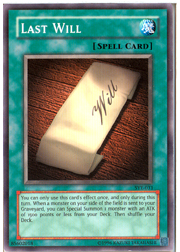 Last Will: While Last Will certainly saw some player interest over the past six months, removing it from the environment has three immediate benefits.
Last Will: While Last Will certainly saw some player interest over the past six months, removing it from the environment has three immediate benefits.
First, players will no longer have to remember its errata’d effect. Any card errata at all is rough, since some players will inevitably be unaware of it. That makes for confusion and negative play experiences, and we won’t have to worry about any of that anymore. The fact that Last Will’s errata was so complicated and esoteric makes it a great card to get rid of.
Beyond that, while Last Will can protect you from Sakuretsu Armor by threatening to fetch you another monster, and it can balance out tribute costs for the patient player, its primary use over the past year has been to support hated OTKs. Eliminating Last Will frees up certain types of cards for future formats.
And hey, it even frees up cards we have now! Exiled Force and Injection Fairy Lily can each go to three per deck because Last Will is no longer around to create abusive combos with them. If one confusing, narrow card can be rotated onto the list to free up several more versatile ones, then that’s a good thing.
Victory Dragon: Aside from creating a huge amount of debate, Victory Dragon never had any sort of impact on the game anyways, and its removal will have virtually no influence over the decisions duelists make. While it’s a fun collectible, this card probably never should have existed, and the sheer difficulty of its summoning requirement made it nearly impossible to use. It will no longer be around to create confusion about concession policy, or to disappoint players who do manage to get it out but who aren’t aware that their opponent can concede the current duel and keep on playing the match. In other words, fewer confused kids, and less debate over a card that was never playable anyways.
Newly Limited To One Per Deck
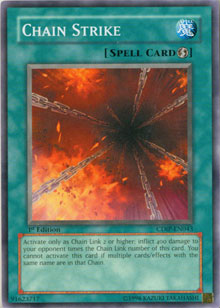 Chain Strike: Limiting Chain Strike is an interesting move. On one hand, it doesn’t kill Chain Strike Burn—limiting Accumulated Fortune would have done more to accomplish that. Limiting Chain Strike just makes the deck trickier to play. On the other hand, it also makes the deck less reliable than it currently is. If you’ve got some experience with Chain Strike Burn, you know that quite often, a win or a loss in game 2 or 3 only comes down to whether or not the opponent can draw his or her side-decked tech cards fast enough to lock you down. Putting Chain Strike to one gives slower decks more of a chance, eliminating a situation where such archetypes had to fear an auto-loss matchup.
Chain Strike: Limiting Chain Strike is an interesting move. On one hand, it doesn’t kill Chain Strike Burn—limiting Accumulated Fortune would have done more to accomplish that. Limiting Chain Strike just makes the deck trickier to play. On the other hand, it also makes the deck less reliable than it currently is. If you’ve got some experience with Chain Strike Burn, you know that quite often, a win or a loss in game 2 or 3 only comes down to whether or not the opponent can draw his or her side-decked tech cards fast enough to lock you down. Putting Chain Strike to one gives slower decks more of a chance, eliminating a situation where such archetypes had to fear an auto-loss matchup.
Crush Card Virus: In an environment where big monsters are the primary means of victory, a card that destroys them all is immensely powerful. Under the right conditions and with a bit of luck, a skilled duelist can fight his or her way back from the activation of Crush Card. If a second Crush Card hits, it goes from being a three-turn condition to a game-long one, and there’s just nothing most decks can do about that.
Fun, powerful, and strategic at one per deck, or broken at two or three . . . pretty easy choice! All in all this won’t be a change to the Western metagame, simply because no single person had access to more than one anyways. We can just rest easy knowing things won’t ever get out of hand.
Dimension Fusion: Chimeratech OTK wasn’t just good because it killed you with Chimeratech Overdragon via Overload Fusion. It was good because it could kill you again with this card, returning a ton of removed Machines that, between Jinzo and Spell Canceller, would leave you with no way to defend yourself.
Limiting Dimension Fusion to one per deck keeps it as a viable part of a whole strategy, but prevents players from relying on it. It takes some of the mechanical teeth out of Chimeratech’s fierce maw, and it also prevents us from ever having to deal with the more broken Destiny Hero decks that have terrorized Japan for the past few months. Those decks focused on removing Warriors from play with Divine Sword - Phoenix Blade, and then returning them with Dimension Fusion. Return from the Different Dimension wasn’t used because it needs to sit on the field for a turn, which at least gave the opponent a chance to stop you. Keeping Dimension Fusion at one makes this deck a lot harder to pull off.
Elemental Hero Stratos: The same can be said for the newest Elemental Hero monster. In the manga and animated series, Jaden uses Stratos to search out other, different Elemental Heroes. In reality, if it were allowed to be used in threes, it’s just going to be used as a superior Gadget monster, or fuel for the aforementioned broken Destiny Hero decks. Like Breaker, this card was simply an auto-in for any deck that needed to run a monster with more than 1600 ATK. There would be almost no reason to consider cards like Kycoo the Ghost Destroyer, D. D. Assailant, and others if Stratos wasn’t Limited.
Now that he is limited, Stratos is a unique source of back-up for Destiny Hero and Elemental Hero decks. He still helps Destiny Heroes put together powerful combos, but he usually only does it once per game, and he doesn’t fill your graveyard with 1800 ATK Warriors to exploit with Phoenix Blade. For Elemental Heroes, he gives the deck a great source of spell and trap removal (at a time when players are now looking for a replacement to Breaker), and he makes searching out Fusion materials a lot easier.
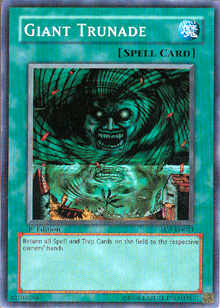 Giant Trunade: As much as I like Trunade myself, I know it for what it is: a kill-card for OTKs. I’ve almost never played it outside of a deck designed to smite my opponent in a single turn. Again, limiting it to one per deck leaves it as a viable substitute for Breaker the Magical Warrior, and lets you still run those OTK decks if you’re willing to work for them, but it reins in the power of unfair combo strategies.
Giant Trunade: As much as I like Trunade myself, I know it for what it is: a kill-card for OTKs. I’ve almost never played it outside of a deck designed to smite my opponent in a single turn. Again, limiting it to one per deck leaves it as a viable substitute for Breaker the Magical Warrior, and lets you still run those OTK decks if you’re willing to work for them, but it reins in the power of unfair combo strategies.
In addition, though most considered the Tundo draw engine to be dead when Giant Trunade was limited to two per deck, some still persisted in running Blasting the Ruins/Life Equalizer OTK decks. Some even made Top 4 finishes at Regionals with them! Trunade going to one will remove this vile little piece of genius from the format once and for all.
Mind Crush: While Mind Crush didn’t pose a huge threat on its own, combining it with Trap Dustshoot took it from being a skill card, to a random turn-one combo based solely on luck that gave you a massive advantage over your opponent. Now it’s gone. This won’t have a huge impact, but it’ll keep one of the game’s more annoying combos under control. Though “CrustShoot” was a popular answer to Gadgets in theory, it didn’t really materialize at SJC Orlando, and it won’t be missed by many. The format will move on without skipping a beat.
Neo-Spacian Grand Mole: Poor Grand Mole. Yu-Gi-Oh’s answer to the Country Bear Jamboree never got much of a chance to see play in multiples, and while that makes honkytonk wildlife sad across the globe, I don’t think players will care much. The number one place to use Grand Mole is in a Giant Rat Toolbox strategy, since Giant Rat can special summon Grand Mole as needed. Because Toolboxes thrive on single copies of situational cards, limiting Grand Mole to one won’t really hamper its use.
So why limit a card most people wouldn’t want to play anyways? When looking at its potential impact, it certainly seems to be the source of some nasty stall power. If your opponent can only summon one monster per turn and you always have Grand Mole face up to block the opponent’s attack, then he or she needs to wait for a piece of proactive monster removal to destroy it before anything can be done. While that’s a clever bit of strategy, it’s also incredibly lame and boring. Previous Forbidden/Limited lists have worked to keep the game at a rather brisk pace, and limiting Grand Mole to one will ensure that we don’t see any “Mole Wall” decks in the near future.
 Overload Fusion: With Overload Fusion and Dimension Fusion each at one per deck, the entire Chimeratech Overdragon OTK concept is severely hampered. Sure, more complicated builds like Paul Lyn’s (which used Ancient Gear Drill to seek out pieces of its combo) will still be able to get to Overload and Dimension Fusion. But they won’t be able to do it as quickly, nor will they be able to do it more than once. Most players hate the idea of losing to an OTK, and whether Overload’s limitation kills Chimeratech off or only slows it down, players are going to be happier.
Overload Fusion: With Overload Fusion and Dimension Fusion each at one per deck, the entire Chimeratech Overdragon OTK concept is severely hampered. Sure, more complicated builds like Paul Lyn’s (which used Ancient Gear Drill to seek out pieces of its combo) will still be able to get to Overload and Dimension Fusion. But they won’t be able to do it as quickly, nor will they be able to do it more than once. Most players hate the idea of losing to an OTK, and whether Overload’s limitation kills Chimeratech off or only slows it down, players are going to be happier.
With Overload Fusion gone, who knows? We might even get Future Fusion back to unlimited status in the future.
Snatch Steal: Perhaps the most debated change to the list, Snatch Steal will keep the whole “Heart of the Cards” concept alive and kicking. While Snatch Steal might seem more powerful than before with Breaker gone, remember that there’s more monster removal now than there was the last time this spell was legal. Magician of Faith’s Forbidden status keeps it from being used again, and Snatch Steal’s presence will give duelists yet another reason to make sure they replace Breaker’s spell and trap removal effect with something else. Dust Tornado will probably become the removal card of choice due to its chainability, and Book of Moon will also see a higher rate of play.
Newly Semi-Limited
D. D. Assailant: Assailant’s presence at two per deck makes Warrior Toolbox and Return-based decks a little bit stronger. These are small shifts, but worthy of note: you can expect to see a higher frequency of both decks at SJC Houston.
The main impact of D. D. Assailant, however, will be its potential as a tech card against Sacred Phoenix of Nephthys. In a removal-driven era, Sacred Phoenix is incredibly powerful, but D. D. Assailant will help to keep it in check and maintain the balance of the game. Nothing too drastic here: just a balancing force that players will be glad to have back as an available option.
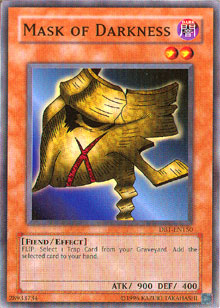 Mask of Darkness: With Time Seal and Tsukuyomi gone, there’s really no reason for Mask of Darkness to be limited to one per deck. It can no longer create game-breaking loops, and because far fewer traps are run than spells, Mask is a bit tougher to play than Magician of Faith ever was.
Mask of Darkness: With Time Seal and Tsukuyomi gone, there’s really no reason for Mask of Darkness to be limited to one per deck. It can no longer create game-breaking loops, and because far fewer traps are run than spells, Mask is a bit tougher to play than Magician of Faith ever was.
As a centerpiece to trap-heavy decks, Mask of Darkness gives unparalleled support power. The ability to reuse Bottomless Trap Hole in a format where Sacred Phoenix has a strong presence will be invaluable, and some duelists will definitely try to replace Magician of Faith with Mask.
Metamorphosis: With Thousand-Eyes Restrict gone from tournament play for quite a while now, we can start reclaiming Metamorphosis, and it couldn’t have happened at a better time. With Sacred Phoenix set to see its fair share of competition, duelists will have easy access to a level 8 monster that can be turned into Cyber Twin Dragon. Zaborg and Cyber Dragon still see plenty of play, and along with Grandmaster of the Six Samurai, each can be turned into Dark Balter the Terrible. The rest of the Monarchs as well as Horus the Black Flame Dragon LV6 and Destiny Hero - Malicious give access to Ryu Senshi. You can even use it in conjunction with Instant Fusion to bring out Reaper on the Nightmare, scoring an immediate direct attack with it the turn it’s brought out.
Again, not a massive change to the format, but one that duelists are sure to experiment with thanks to synergy with recent releases.
No Longer Limited:
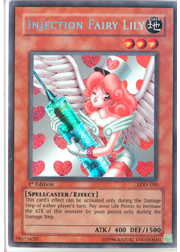 Injection Fairy Lily: A favorite change for many, multiple copies of Lily are a boon to Spellcaster and Earth decks. In the former, she’s one more high-impact, versatile monster to add another hit for Magical Dimension and Magician’s Circle. In an Earth swarm she provides more power to your rush, and in Giant Rat Toolbox she’s a trick that’s often worth pulling off twice.
Injection Fairy Lily: A favorite change for many, multiple copies of Lily are a boon to Spellcaster and Earth decks. In the former, she’s one more high-impact, versatile monster to add another hit for Magical Dimension and Magician’s Circle. In an Earth swarm she provides more power to your rush, and in Giant Rat Toolbox she’s a trick that’s often worth pulling off twice.
While Lily’s unlimited status will certainly help her see more play, she’s far from broken. Snatch Steal and Lily can be used together to create huge swings in life points, but Change of Heart (which created problems in conjunction with multiple copies of Lily when she was first released) is no longer around to add to her game-ending combo potential. In addition, Lily has never been unlimited in a removal-heavy format, which will help curb her more aggravating tendencies. In a format that might be a bit slower than the last, Lily adds a dose of speed.
Exiled Force: With Last Will gone, Exiled Force loses the number-one combo it had going for it. The two decks that want to play it most, Giant Rat Toolbox and Warrior Toolbox, don’t really need more than two copies anyway, so don’t expect this change to have a huge effect on the game. For those who want to run three Exiled, the option is now there, but few duelists will want to do so.
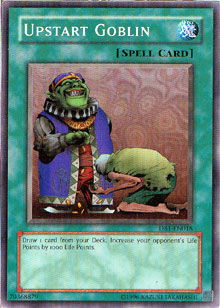 Upstart Goblin: Between the limitation of Overload Fusion and Dimension Fusion, and the Forbidden status of Last Will, this list does a lot to mitigate OTK strategies. As a result, Upstart Goblin becomes less of an OTK-enabler and more of a refined combo tool. It’s unlikely that it will become a popular card, but again, the option is now available and that’s a good thing.
Upstart Goblin: Between the limitation of Overload Fusion and Dimension Fusion, and the Forbidden status of Last Will, this list does a lot to mitigate OTK strategies. As a result, Upstart Goblin becomes less of an OTK-enabler and more of a refined combo tool. It’s unlikely that it will become a popular card, but again, the option is now available and that’s a good thing.
Sacred Phoenix of Nephthys: This is probably the biggest change on the list. Right now, dueling is dominated by monster removal effects. Zaborg defined the format for months, and though the new tour-de-force mainstream strategy is Gadgets, those are even heavier on monster removal. Duelists are definitely going to bring dedicated Sacred Phoenix decks to high-level tournaments, and the result will be a lot of pressure on removal-heavy strategies.
Playing Phoenix isn’t as easy as playing Monarchs. You have to play around Bottomless Trap Hole, D. D. Warrior Lady, and D. D. Assailant very carefully, or else all your effort can be wasted by a single remove-from-game effect. Still, the power that it grants is significant, and the flexible range of plays Phoenix allows makes it a versatile threat. It was already seeing play in some Monarch decks at SJC Orlando, and we can expect to see that trend continue into the new format. Dedicated Phoenix, Winged-Beast, and Destiny Hero - Dasher strategies may all see success in this format, and all of them will certainly see play.
All in all, this new Forbidden/Limited list manages to tweak a pretty successful format and remove some of the luck factor. OTKs are no longer such an issue and solitaire decks like Chain Strike Burn and Life Equalizer become a bit more difficult. Cards that offer a high reward for very little applied skill have been curbed, and some of the game-wrecking brokenness that’s been terrorizing Japan gets preempted. In addition, Upper Deck Entertainment’s campaign to get things off the list that don’t need to be there continues to be successful.
The new format is in no way a drastic change from the old one, but it’s definitely going to demand a bit more tactical skill. Considering that this format kicks off the journey to the World Championship, that seems like a good thing, and with so many promising new set releases on the horizon, it looks like we’re in for an exciting summer.